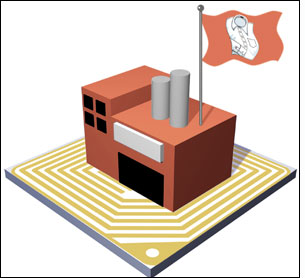Here’s a look at some of the deployments RFID Journal has covered.
The Basic House Increases Efficiencies
The Basic House is a Korean clothing company that manufactures four fashion brands, which it sells at its own brand-specific stores, as well as at department stores operated by other retailers. It has deployed an RFID system at its manufacturing sites, distribution centers and stores to improve efficiencies and reduce out-of-stocks. The company also expects the RFID system to enable the firm to better forecast and plan the manufacturing and shipping of its garments based on more accurate inventory counts, according to Daan Jang, The Basic House’s general manager.
|
|
Esquel Tracks Work-in-Process
Hong Kong-based Esquel manufactures high-end cotton shirts for some of the world’s best-known brands, including Abercrombie & Fitch, Brooks Brothers, Hugo Boss, Lands’ End, Nike and Tommy Hilfiger, as well as such major retailers as Jusco, Marks & Spencer and Nordstrom. Esquel uses RFID to track its cotton inventory and work-in-process. Tags are attached to cotton bales and assigned a quality
rating. The RFID system ensures that bales that look identical but are of different quality are used for the right shirts. Esquel also tags piece parts that are cut in Hong Kong and shipped to China for sewing. The system ensures that the proper parts can be identified quickly and tracked through sewing stations, increasing worker productivity.
G&P Net Protects Its Brand
Garment manufacturer G&P Net has deployed RFID at its four distribution centers in Italy to control distribution and combat gray-market sales, which tarnish product image and cost the manufacturer millions of euros in reduced product value and legal fees. Prior to using RFID, there was no way to track items once they were shipped from a DC to a retailer—and to determine how unauthorized sellers got hold of its garments. With RFID, G&P Net has much greater visibility. At garment factories throughout Asia and Europe, workers attach an EPC Gen 2 UHF tag to each item; the unique ID number encoded to the tag is linked to data regarding the specific garment, such as its size and style, as well as where and when it was manufactured. Software records individual items received at a DC, and to which retail outlet they are shipped. This allows G&P Net to maintain records as to which retailer received each specific item. In the event that the company learns of an unauthorized seller, G&P Net can scan the RFID number on the garment’s tag and immediately determine who previously had possession of that product.
Seidensticker Improves Receiving Processes
Like other manufacturers, German shirt maker Seidensticker experiences delays when boxes are packed incorrectly and their contents do not match the packing list. But its new RFID system identifies boxes that are packed incorrectly so they can be repacked before they’re sent to retailers, saving the company transport and packaging costs. The garments are tagged in Asia and read when they arrive at Seidensticker’s distribution center in Bielefeld, Germany. Workers place boxes of almost 50 individually tagged shirts, for instance, on a moving belt that goes through a virtual tunnel reader. The garments’ EPC Gen 2 tags are read, and the contents of each box are compared with the information on the packing list. Once the system notifies workers that the carton’s contents are correct, they sort garments based on orders and ship them to retailers. Seidensticker is expected to tag 4 million shirts in 2010, and eventually all 13 million shirts it produces under various brands each year.


